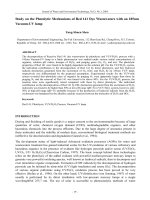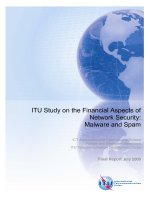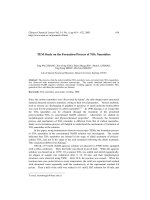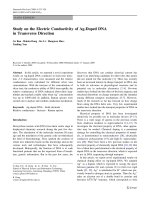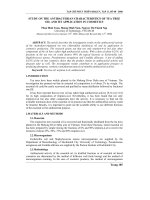study on the immune response of orange spotted grouper (epinephelus coioides hamilton, 1822) cultured in khanh hoa province to bacteria vibrio parahaemolyticus
Bạn đang xem bản rút gọn của tài liệu. Xem và tải ngay bản đầy đủ của tài liệu tại đây (641.46 KB, 28 trang )
MINISTRY OF EDUACATION AND TRAINING
NHA TRANG UNIVERSITY
NGUYEN THI THANH THUY
STUDY ON THE IMMUNE RESPONSE OF ORANGE -
SPOTTED GROUPER (Epinephelus coioides Hamilton,
1822) CULTURED IN KHANH HOA PROVINCE TO
BACTERIA Vibrio parahaemolyticus
Speciality : Aquaculture
Code : 62 62 03 01
ABSTRACT OF DOCTORAL DISSERTATION
KHANH HOA - 2014
The dissertation was finished at Nha Trang University
Supervisors:
1. Dr. Nguyen Huu Dung - Nha Trang University
2. Prof.Dr. Heidrun I. Wergeland- Bergen University, Norway
Reviewer 1: ………………………………
………………………………
Reviewer 2: ………………………………
………………………………
Reviewer 3: ………………………………
………………………………
The dissertation was defended at Dissertation Assessment Committee
of Nha Trang Uiniversity
At ………, date …… ……… …
The dissertation can be found at:
National Library
Nha Trang University’s Library
1
INTRODUCTION
1. Necessity of research
Orange-spotted grouper Epinephelus coioides has high
nutritional value for human consumption, grow fast and is cultured in
many countries. In recent years, various infectious diseases has
caused major problems for the farming of grouper. Among these, a
continuously occurring disease is, ulcerative disease caused by Vibrio
bacteria. The economic loses for grouper farmers, due to this disease,
have been extensive.
Up to now, antibiotics and chemicals for prevention and
treatment of Vibriosis in grouper have not showed suitable or had an
acceptable effect. In addition, it is important to keep in mind that
preventive use of antibiotics is not acceptable and continuous use
often result in occurrence of resistant bacteria. Immunoprophylactic
measures like vaccines are therefore highly recommended. Thus,
basic research on grouper immunology and responses to pathogens
will provide more information about the mechanism involved in
disease protection. The characterization of the pathogen(s) with
regard to pathogenicity and immunostimulatory abilities to obtain the
required protection is therefore necessary. The knowledge and results
obtained by such studies can be applied for fish vaccine development
and vaccine production. Such new vaccine approach is highly
demanded for development of marine fish farming. The use of
vaccines to avoid diseases and spread of pathogens also lead to
reduced or no use of antibiotics and chemicals and will thus promote
sustainable and ecologically acceptable environment in farming areas.
2
2. Aims and contents of research
2.1. Aims of research
Study the immune response of orange-spotted grouper to Vibrio
parahaemolyticus.
2.2. Contents of research
Study on characteristics of V. parahaemolyticus causing the
ulcerative disease in grouper.
Study on the effect of oral administration β-glucan on the
native immune response of orange-spotted grouper.
Study on the specific immune response of orange-spotted
grouper to formalin killed cells of V. parahaemolyticus.
3. Significance and new conclusions from this dissertation
The results of the dissertation contribute with scientific
information about the immune response of orange-spotted grouper to
Vibrio. This provide a scientific basis for vaccine production and for
the use immunostimulants to prevent vibiosis in marine fish in
Vietnam.
This is the first publication about immune response as well as
effect of oral administration β-glucan in cultured grouper in Vietnam.
4. Structure of dissertation
The dissertation includes 127 pages, 27 figures, 6 tables, and 219
references. The structure of dissertation consists of introduction (3
pages); Chapter 1: Litterateur review (36 pages); Chapter 2: Materials
and Methods (17 pages); Chapter 3: Results and Discussion (46 pages);
Chapter 4: Conclusions and Suggestions (2 pages); References (23
pages) and Indexes (19 pages).
3
CHAPTER 1: LITTERATEUR REVIEW
1.1. Orrange spotted grouper Epinephelus coioides
1.1.1. Biological characteristics
Biological characteristics such as morphology, distribution,
growth, nutrition, reproduction and larval characteristics of grouper
generation and orange-spotted grouper specificity has been reviewed
from previous reports (Randall et al, 1991; Grandcourt et al, 2003;
Lauro et al, 2012; Nguyen Nhat Thi, 1991 ).
1.1.2. Grouper farming industry in the world and Vietnam
Grouper has been cultured since 1970s in some Asian countries
and in Vietnam, since 1988. Main cultured areas for grouper farming are
Hai Phong, Phu Yen, Khanh Hoa, Vung Tau.
1.1.3. Common diseases in grouper
Infections in grouper by virus, bacteria, parasites have been
reported from many countries including Vietnam. Among the
pathogens, Vibrio was the most common agents with fast spread and
caused lot of fish health problems and losses for the farmers (Sarjito
et al., 2009; Sun et al., 2011; Yambot and Song, 2006; Do Thi Hoa et
al., 2008 ).
1.2. Vibrio and vibriosis in marine fish
1.2.1 Vibrio
Characteristics of structure, morphology, physiology,
bioecology, biochemical and virulent factors of Vibrio are described
in many publications including from Vietnam.
1.2.2 Vibriosis in marine fish
Many marine fishes in different areas have shown to be
infected with Vibrio bacteria. Extensive haemorrhagic septicemia and
ulceration of the skin, fins and tail are common symptoms of this
4
disease. The disease causes severe infection and often result in high
mortality. The common agents of this disease are V.
parahaemolyticus, V. vulnificus, V. alginolyticus, V. cachariae. The
extensive use of chemicals and antibiotics for prevention and
treatment ulcerative disease have resulted in reduced or no effect.
1.3. Fish immune systems
1.3.1. Non-specific immune system
The difference aspects of fish non-specific immune system
have been reviewed by Ellis (2001), Rombout et al. (2005),
Magnadottir (2006), Whyte (2007), Chistiakov et al. (2007), Van
Muiswinkel (2008).
1.3.2. Specific immune system
Up to now, most research related to fish specific immune
responses are conducted on salmon, common carp and catfish
(Rombout et al., 2005; Swain et al., 2007; Uribe et al., 2011 ).
A few studies on the immune system and responses of grouper
have been published such as ontogenesis of lympho organs, IgM
characteristic, trials vaccine and immunostimulants (Lin et al., 2005;
Kato et al., 2004; Harikrishnam et al., 2011).
1.3.3 Influence factors for fish immune responses
Factors affecting fish immune responses include factors related
to fish ontogenesis. Among environmental factors, temperature has
been shown to greatly influence the fish immune responses.
1.4. Vaccine and immunostimulant trials for fish
1.4.1. Immunostimulation of fish
There are 22 immunostimulants, which have been applied to
grouper by the farming industry.
5
1.4.2. Vaccine for fish
The use of commercial fish vaccines and experimental vaccine
testing are conducted many places in the world. Most vaccines are
developed and tested for cold water fish such as salmon, cod, catfish,
carp.
1.5. Research on fish immune system and fish vaccination in
Vietnam
In Vietnam, the research in fish immunology and vaccination
has still relatively new. A few studies on freshwater fish were carried
out while research on the immunological characteristics of marine
fish has still uninterested, including grouper. The first commercial
fish vaccine for Pangasius against Edwardsiella ictaluri has now
been approved in Vietnam.
CHAPTER 2: MATERIALS AND METHODS
2.1. Object, materials, location and period of research
2.1.1. Object: Orange-spotted grouper Epinephelus coioides
2.1.2.Materials:
i) Orange-spotted grouper: Infected fish were collected from
cage culture fish in Khanh Hoa province and used for isolation of
bacteria. Healthy orange-spotted grouper were purchased from
hatcheries in Khanh Hoa province and were acclimatized before start
of the experiments.
ii) Bacteria, V. parahaemolyticus, strain V3 was isolated from
ulcerative infected grouper which were collected in Khanh Hoa; Strain
V1 was kindly supplied by The center of monitoring environment and
disease in the North Vietnam; Strain V2 was kindly supplied by The
center of monitoring environment and disease in the South Vietnam;
Strain A was reference strain V. parahaemolyticus 17802 ATCC.
6
iii) Immunostimulant: β-glucan was kindly supplied by
Macrogard-Biorigin, Norway.
2.1.3. Research location: Research Institute for Aquaculture No. 3 and
Fish immune laboratory, Biology section, Math and Natural science
department, Bergen University, Norway.
2.1.4. Research period: From January, 2008 to December, 2012.
2.2. Research methods
2.2.1. Characteristics of V. parahaemolyticus
Morphological, physiological and biochemical characteristics
Isolate and study the morphological, physiological and
biochemical characteristics of the bacteria according to Whitman
(2004). Identification of bacteria is based on Bergey’s taxonomy keys
and sequence 16S rDNA gene according to Harris and Hartley
(2003).
Analysis protein profiles of bacteria
Follow the SDS-PAGE method of Tsang et al., 1983.
Challenging testing of grouper by using V. parahaemolyticus
Orange-spotted grouper were challenged by V.
parahaemolyticus V1, V2, V3 and A at 10
2
, 10
3
, 10
4
and 10
5
cfu/g by
intramuscular injection. The control group was injected with sterile
Phosphate Buffered Saline (PBS). There were 6 fish and two
parallels per group.
The virulence of the bacteria was determined by lethal dose
50% following the procedure according to Reed and Muench (1938).
2.2.2. The effect of oral administration β-glucan on non-specific
immune responses of orange-spotted grouper
The experiment was carried out including 3 differential
concentrations of oral administration β-glucan (500 ppm, 1000 ppm
7
and 2000 ppm) and control group (without using β-glucan). There
were 30 fish/treatment in double replicates. The pellet feed (M503,
Uni-president Vietnam) mixed β-glucan with squid oil outside was
fresh prepared. Fish were given this diet during 2 weeks with 2 %
BW/day. After the diet period, the fish was feed with pellet feed.
Sampling: At 1
st
day and at 15
th
day after stopping diet
supplemented with β-glucan, 6 fish/treatment were used for blood
samples and sampled of head kidney were used for isolation of
leucocytes.
Determination of WBC in blood: Blood smears were used
for counting blood cells according to Selvaraj et al. (2006).
Identification of leucocytes was done according to Ainsworth (1992).
Analysis non-specific immune parameters of head kidney
leucocytes (HKL): HKL were isolated by centrifugation on percoll
gradient following the procedure of Yeh et al. (2008); Observation of
phagocytic activity was based on the ability to ingest the fluorescent
beads of HKL according to Yeh et al. (2008); The respiratory burst
activity of HKL were measured according to Cheng et al. (2007).
Survey of disease resistance of orange-spotted grouper after
eating β-glucan: At the 1
st
and 15
th
day after stopping the β-glucan
diet supplement, 24 fish/group were injected with virulent V.
parahaemolyticus V3 at 1.07 x 10
5
cfu/g and the mortality were
monitored during the challenge period of 2 weeks.
2.2.3. Characteristic of the IgM immunoglobuline of orange-
spotted grouper.
Grouper sera were collected according to Aakre et al. (1994);
IgM was purified from serum on FPLC chromatography system
8
(Pharmacia, Uppsala, Sweden) according to Havarstein et al. (1988).
Analyze IgM by SDS-PAGE according to Tsang et al. (1983).
Production of rabbit antiserum to grouper IgM: The rabbit was
immunized 3 times (at 4 week intervals) by subcutaneous injection
with 0.2 mg IgM and adjuvant (FCA or FIA) with a ratio 1:1 (v /v).
Rabbit sera were collected 2 weeks after the last injection and stored
at -70
o
C.
Immunoreaction between grouper IgM and rabbit antiserum
was detected by Western Blot according to Towbin et al. (1979).
2.2.4. Study on the specific immune response of orange-spotted
grouper to V. parahaemolyticus
Antigen: Bacteria was inactivated by 0.5% formalin (v/v).
Bacterin was resuspended in PBS and mixed 1:1 (v/v) in Freundʼ s
incomplete adjuvant (FIA, Difco) to 10
9
cfu/mL.
Antibody response of orange-spotted grouper to bacterin
without FIA: Bacterin of strains V1, V2, V3 and A were used to
immunized for 20 fish/strain with 0.1 mL/fish. Control group was
injected 0.1 mL sterilized PBS. The experiment was carried out with
two replicates. At 30, 45 and 60 days post vaccination, blood from
the caudal vein of 10 fish from each treatment was sampled for sera
collection. Specific antibodies in fish sera were analyzed by ELISA
following Jakobsen et al. (1999).
The antibody response of orange-spotted grouper to the
bacterin containing FIA and the protective efficacy testing:
The experiment was conducted with 4 treatments including
V3F (fish were immunized with bacterin V. parahaemolyticus V3
mixed FIA), V3 (fish were immunized with bacterin V.
parahaemolyticus V3 without FIA), PBS-C (control group were
9
injected by PBS) and C (control group without PBS injection). Each
treatment contained 50 fish ( 49.8 ± 12.8 g) using two paralells.
At 30, 45 and 60 days post vaccination, blood from the caudal
vein of 10 fish from each treatment was sampled for collection of
serum. Immunoreaction between antibodies in fish sera and the
antigen’s protein was detected by Western Blot following Towbin et
al. (1979) and specific antibodies were measurement in fish sera by
ELISA according to Jakobsen et al. (1999).
Twenty fish/treatment were randomly selected for challenge by
intramuscular (i.m.) injection with V. parahaemolyticus 2.5 x 10
5
cfu/g at 30 days post immunization and 2.0 x 10
5
cfu/g at 60 days
post immunization. The relative percent survival (RPS) that
considered as the protective efficacy was calculated according to
Ellis (1988).
2.3. Data analysis:
Data were analysed by Chi- test and ANOVA-one factor with
Tukey HSD Post hoc test on SPSS version 15.0 (P< 0.05).
CHAPTER 3: RESULTS AND DISCUSSION
3.1. Characteristics of Vibrio parahaemolyticus causing ulcerative
disease on orange-spotted grouper
3.1.1. The ulcerative disease on cultured grouper in Khanh Hoa
province
Among 24 infected grouper in Khanh Hoa collected from
Match to July, 2008, the frequency of signs of disease was different
depended on infectious situation. Particularly, 100 % samples were
hemorrhage on the mouth and fin; 75 % samples with ulcer on skin;
62.5 % samples with pale liver; 58.3 % samples with dark kidney and
33.3 % samples with accumulate fluid in the peritoneal cavity.
10
From infected grouper, 16 strains of V. parahaemolyticus
were isolated with frequency at 66.7%. In particular, strains C07K
isolated from kidney exhibited the highest virulent with LD
50
at 2.14
x 10
3
cfu/g. This strain is named as V3 and is used for comparison
with strain V. parahaemolyticus V1, V2 and A.
3.1.2. Characteristics of Vibrio parahaemolyticus
3.1.2.1. Morphological, physiological, biochemical characteristics
Morphological, physiological, ecological characteristics of 4
studied strains (V1, V2, V3 and A) showed similar such as negative
Gram, short rod-shaped, mobility, green colonies on TCBS with high
salt tolerance to 8 % in TSB and rabbit erythrocyte lysis on agar.
However, strain V3 showed β erythrocyte lysis type while 3 other
strains of α type.
Strain V1, V2, V3 are similar to the reference strain ATCC 17802
and were identified V. parahaemolyticus according to Bergey’s
taxonomic key and sequence of 16S rDNA gene.
3.1.2.2. Protein profile of V. parahaemolyticus
Four strains of V. parahaemolyticus showed similar protein
profiles. Among these, proteins with molecular weight as 66, 47, 31,
28 and 21 kDa were homologous to toxic and high antigenic proteins
as previous reports (Figure 3.5). This finding is significant discovery
for selection of potential strains for fish vaccine production.
11
Figure 3.5: Protein profiles of Vibrio parahaemolyticus
3.1.3. Virulence of V. parahaemolyticus on orange-spotted grouper
The challenging test showed that strain V3 exhibited the
highest virulence comparing with other strains V1, V2 and A with
LD
50
as 1.78 x 10
3
cfu/g (Figure 3.6).
12
Figure 3.6: Accumulative mortality of orange-spotted grouper
challenged with Vibrio parahaemolyticus (a: Strain V1; b: Strain
V2; c: Strain V3; d: Strain A)
3.2. Effect of oral administration β-glucan to non-specific immune
parameters and disease resistance of orange spotted grouper to V.
parahaemolyticus
3.2.1. Composition, morphological characteristics and size of
blood cells of orange-spotted grouper
Similar to many other fish bones species, orange-spotted
grouper has adequate types of blood cells. Composition, size and
image of grouper’s blood cells were showed in Table 3.2 and Figure
3.8.
0
10
20
30
40
50
60
70
80
90
100
0 24 48 72 96 120 144 168 192 216 240
Thời gian (giờ)
Tỷ lệ chết tích lũy (%)
ĐC 10^2cfu/g 10^3 cfu/g
10^4 cfu/g 10^5 cfu/g
0
10
20
30
40
50
60
70
80
90
100
0 24 48 72 96 120 144 168 192 216 240
Thời gian ( giờ)
Tỷ lệ chết tích lũy (%)
ĐC 10^2 cfu/g 10^3 cfu/g
10^4 cfu/g 10^5 cfu/g
0
10
20
30
40
50
60
70
80
90
100
0 24 48 72 96 120 144 168 192 216 240
Thời gian (giờ)
Tỷ lệ chết tích lũy (%)
ĐC 10^2 cfu/g 10^3 cfu/g
10^4 cfu/g 10^5 cfu/g
0
10
20
30
40
50
60
70
80
90
100
0 24 48 72 96 120 144 168 192 216 240
Thời gian (giờ)
Tỷ lệ chết tích lũy (%)
ĐC 10^2 cfu/g 10^3 cfu/g
10^4 cfu/g 10^5 cfu/g
a. LD
50
> 10
5
cfu/g
b. LD
50
= 2.14 x 10
4
cfu/g
d. LD
50
= 1.48 x 10
4
cfu/g
c. LD
50
= 1.78 x 10
3
cfu/g
Accumulative mortality (%)
Accumulative mortality (%)
Accumulative mortality (%)
Accumulative mortality (%)
Post injection (h)
Post injection (h)
Post injection (h)
Post injection (h)
13
Table 3.2: Composition and size of orange spotted grouper’s blood cells
(n = 15, mean ± std)
Type of cell
Size
Nuclear size
Lenght
(µm)
Width
(µm)
Lenght
(µm)
Width
(µm)
Erythrocyte
11.4 ± 1.1
7.1 ± 0.8
5.3 ± 0.5
4.3 ± 0.5
Neutrophil
9.3 ± 2.2
7.7 ± 1.3
6.8 ± 0.7
5.2 ± 0.7
Eosinophil
8.1 ± 1.1
6.4 ± 0.6
5.5 ± 0.6
4.6 ± 0.8
Basophil
6.6 ± 0.9
5.8 ± 0.9
5.8 ± 0.7
3.9 ± 1.0
Monocyte
9.9 ± 1.5
8.8 ± 1.3
7.1 ± 0.9
4.5 ± 0.9
Lymphocyte
6.0 ± 0.9
5.1 ± 0.5
Thrombocyte
7.6 ± 1.1
3.9 ± 0.9
Figure 3.8: Blood cell composition of orange spotted grouper (M-
Monocyte; L-Lymphocyte; T- Thrombocyte; N-Neutrophil;E-
Eosinophil; B- Basophil; Er- Erythrocyte)
14
3.2.2. Effect of oral administration β-glucan to leucocytes of
orange-spotted grouper
After 2 weeks with diet β-glucan supplement, the rate of
leucocytes total, neutrophils and monocytes of orange-spotted
grouper increased and the difference was statistically significant (P
<0.05) compared with control group. In particular, group of β-glucan
supplement as 1000 ppm and 2000 ppm obtained the highest ratio of
leucocytes (Table 3.3).
Table 3.3: The ratio of leucocytes of orange-spotted grouper after
2 weeks supplement β-glucan (%, mean ± std, n = 6)
Leucocyte
Treatments
ĐC
G500
G1000
G2000
Leucocyte total
3.3 ± 0.6
a
4.2 ± 0.4
b
5.3 ± 0.4
c
6.0 ± 0.5
c
Neutrophil
21.5±2.8
a
23.6± 4.4
ab
27.9 ± 1.9
b
27.1 ± 3.3
b
Monocyte
18.7± 8.0
a
26.4 ± 3.7
ab
26.5 ± 5.4
ab
27.6 ± 2.5
b
Eosinophil
4.9 ± 2.4
a
5.2 ± 1.3
a
4.9 ± 1.4
a
4.1 ± 0.7
a
Basophil
5.0 ± 0.9
b
3.3 ± 0.6
a
3.0 ± 0.8
a
2.4 ± 0.8
a
Lymphocyte
50.0 ± 7.0
b
41.5 ± 5.8
ab
37.7 ± 4.3
a
38.9 ± 6.5
a
Note: The different exponent symbols on the same row indicate
statistically significant difference (P <0.05)
3.2.3. Effect of oral administration β-glucan to phagocytic
activity of orange-spotted grouper head kidney leucocytes
After 2 weeks with diet β-glucan supplement, phagocytic index
of HKL of fish increased and the difference was statistical
significance compared with the control group. However, after 15
days stopping diet β-glucan supplement, this index declined. In
particular, β-glucan supplement of 1000 ppm expressed the most
effective on grouper (Table 3.4).
15
Table 3.4: Phagocytic index of head kidney leucocytes of orange-
spotted grouper using feed supplemented β-glucan
Time
Treatment
Phagocytic
index (%)
Phagocytic intensity ( %, n = 6, mean ±
std)
1 bead
2 beads
> 3 beads
At 1
st
day stopping diet
supplement
β-glucan
ĐC
13.3 ± 2.3
a
6.3 ± 1.6
a
4.4 ± 0.3
a
2.6 ± 0.5
a
G500
6.0 ± 2.1
ab
7.3 ± 0.5
ab
5.0 ± 0.9
ab
3.7 ± 1.0
a
G1000
26.0 ± 7.1
c
12.1 ± 2.6
c
6.9 ± 2.4
b
7.0 ± 3.3
b
G2000
20.7 ± 1.2
bc
9.1 ± 1.2
b
6.2 ± 0.7
ab
5.3 ± 1.4
ab
At 15
th
days
stopping diet
supplement
β-glucan
ĐC
13.5 ± 0.9
a
6.2 ± 1.0
a
4.9 ± 0.6
a
2.4 ± 0.3
b
G500
13.8 ± 0.8
a
7.4 ± 0.8
a
4.5 ± 0.9
a
2.0 ± 0.2
a
G1000
13.3 ± 0.4
a
7.1 ± 0.4
a
4.0 ± 0.6
a
2.2 ± 0.2
ab
G2000
13.5 ± 1.1
a
7.2 ± 0.8
a
4.2 ± 0.4
a
2.0 ± 0.2
a
Note: The different exponent symbols on the same column indicate
statistically significant difference (P <0.05)
3.2.4. Effect of oral administration β-glucan to respiratory burst
activity of head kidney leucocytes of orange-spotted grouper
Respiratory burst activity of HKL of orange-spotted grouper
were fed β-glucan supplement at 1000 ppm and 2000 ppm in 2 weeks
increased and was statistical significant difference from 500 ppm
group and control group. However, this index was not different after
15 days stopping diet ( Figure 3.11).
16
Figure 3.11: Respiratory burst of head kidney leucocytes of
orange spotted grouper Epinephelus coioides (A: At 1
st
day
stopping diet supplement β-glucan; B: At 15
th
day stopping diet
supplement β-glucan; The different letters on columns indicate
statistically significant difference (P <0.05)
3.2.5. Effect of oral administration β-glucan to disease resistance
of orange-spotted grouper to Vibrio parahaemolyticus
After 2 weeks using β-glucan, fish were challenged with wild
bacteria, the results showed that the accumulative mortality (%) of
fish in groups using β-glucan were significantly lower than the
control group. However, this rate did not differ after 15 days stopping
diet β-glucan supplement (Figure 3.12).
Figure 3.12: Accumulative mortality of orange spotted
grouper challenged with Vibrio parahaemolyticus at the 1
st
(a) and 15
th
(b) day stopping diet β-glucan supplement
a
b
b
a
a
a
a
a
0,0
0,2
0,4
0,6
0,8
1,0
1,2
1,4
1,6
1,8
Hoạt tính RB (OD 630 nm)
ĐC G2000 G1000 G500
A B
Respiratory burst (OD 630
nm)
0
10
20
30
40
50
60
70
80
90
100
1 2 3 4 5 6 7 8 9 10
Ngày
Tỷ lệ chết tích lũy ( %)
G-500 ppm G-1000 ppm G-2000 ppm ĐC
0
10
20
30
40
50
60
70
80
90
100
1 2 3 4 5 6 7 8 9 10
Ngày
Tỷ lệ chết tích lũy (%)
G-500 ppm G-1000 ppm G-2000 ppm ĐC
a
b
Accumulative mortality (%)
Accumulative mortality (%)
Post injection (day)
Post injection (day)
17
3.3. Specific immune response of orange-spotted grouper to
Vibrio parahaemolyticus
3.3.1. Characteristic of IgM of orange-spotted grouper
IgM of orange-spotted grouper consists of a heavy chain and a
light chain with molecular weight as 78 kDa and 25 kDa, respectively.
Besides, the globuline molecule has a polypeptide 23 kDa that its function
in the structure of this molecule was not known yet (Figure 3.13).
3.3.2. Antibody response of orange-spotted grouper to 4 strains
Vibrio parahaemolyticus activated by formaline without FIA
After 30 and 45 days post immunization by inactivated V.
parahaemolyticus, specific antibodies in grouper sera was higher
than in the control group (P <0.05). In particular, bacterin V3
stimulated grouper to produce the highest antibodies. This response
did not differ between experimental groups of fish after 60 days post
immunization (Figure 3.14).
97.4
66.2
31.0
21.5
14.4
kDa 1 2 3 4 5
H
L
Figure 3.13: Globuline molecule (IgM) of orange-spotted
grouper was analysed by SDS-PAGE and Western Blot (1:
Marker; 2, 3: IgM grouper on SDS-PAGE; 4, 5: Bound between IgM
and rabbit antisera on Western blot; H: Heavy chain; L: Light chain)
18
Figure 3.14: Antibody titer of orange-spotted grouper immunized
bacterin Vibrio parahaemolyticus was measured by ELISA (Symbol
on columns in the same period indicate significant difference (P<
0.05) with Tukey, n=10)
3.3.3. Humoral specific antibody response and disease resistance
of orange-spotted grouper immunized by bacterin V.
parahaemolyticus V3 with FIA
3.3.3.1. Immunodetection in grouper sera
After immunization with bacterin V. parahaemolyticus,
Immunoreactive bands between antibodies of fish sera and proteins
of antigens was observed in all sera samples from vaccinated grouper
while no immunoreactive band was in the control sera. Moreover,
most of strongest immunoreactive bands was found in sera from fish
immunized with antigen mixed FIA. Then, the immunoreaction
tended to be weaker at post vaccination expressing by less and weak
bands (Figure 3.15).
30 45 60
Thời gian sau khi gây miễn dịch (Ngày)
c
b
b
d
a
c
b
b
d
a
a
a
a
a
a
0,00
0,05
0,10
0,15
0,20
0,25
0,30
A V1 V2 V3 ĐC
Mật độ quang (OD 490nm)
Antibody titer (OD 490 nm)
Post immunization (day)
19
Figure 3.15: Immunoreaction between orange-spotted grouper
antibodies and proteins of Vibrio parahaemolyticus V3 by Western
Blot (1: Marker; 2,3,4: Bacterin with FIA at 30, 45 and 60 days; 5,6, 7:
Bacterin without FIA at 30, 45 and 60 days; 8: control group)
3.3.3.2. Humoral antibodies response of orange-spotted grouper
immunized by bacterin V. parahaemolyticus V3
Levels of specific antibodies in sera of fish immunized with
bacterin combine FIA showed the highest and statistically significant
difference at the time of 30, 45 and 60 days post immunization
(Figure 3.16).
20
Figure 3.16: Antibodies response of orange-spotted grouper
immunized by bacterin V. parahaemolyticus V3 measured by
ELISA at 490 nm (V3+ FIA: Bacterin with FIA; V3: Bacterin; PBS-C:
Control group with PBS and C: Control group; Symbols on colunm
indicate statistically significant difference (P< 0,05) by Tukey, n=10)
3.3.3.3 Disease resistance of immunized orange-spotted grouper
to pathogen
a. At 30 days post immunization
At 30 days post immunization, disease resistance of immunized
fish was higher than this ability of control group. (Figure 3.17).
Relative percent survival (RPS) value was the highest in group
immunized with antigen combine FIA as 87.5 %, while RPS value in
group immunized without FIA was only 50 %.
a
b
c
d
a
b
c
d
a
b
b
b
0,00
0,05
0,10
0,15
0,20
0,25
30 45 60
Mật độ quang (OD 490nm)
V3 + FIA V3 PBS-C C
Thời gian sau khi gây miễn dịch (ngày)
Antibody titer (OD 490 nm)
Post immunization (day)
21
Figure 3.17: Accumulative mortality of orange-spotted grouper
at 30 days post immunization (V3+FIA: bacterin with FIA; V3:
Bacterin; PBS-C: Control group with PBS; C: Control group)
b. At 60 days post immunization
At 60 days post immunization, protective ability of antigen on
grouper was not effect (Figure 3.18). RPS value was only 41.1 % at
fish immunized with bacterin combine FIA and 10.9 % at group
without FIA.
0
10
20
30
40
50
60
70
80
90
100
0 1 2 3 4 5 6 7 8 9 10
Ngày
Tỷ lệ chết tích lũy (%)
V3+FIA V3 PBS-C C
Accumulative mortality (%)
Post injection (day)
0
10
20
30
40
50
60
70
80
90
100
0 1 2 3 4 5 6 7 8 9 10
Ngày
Tỷ lệ chết tích lũy (%)
V3+FIA V3 PBS-C C
Accumulative mortality (%)
Post injection (day)
Figure 3.18: Accumulative mortality of orange-spotted grouper
at 60 days post immunization (V3+FIA: bacterin with FIA; V3:
Bacterin; PBS-C: Control group with PBS; C: Control group)
22
CHAPTER 4: CONCLUSIONS AND SUGGESTIONS
Conclusions
1. Morphological, physiological, biochemical characteristics
of strain V. parahaemolyticus V3 were similar to reference strain
ATCC 17802. Strain V3 caused ulcerative disease for orange-spotted
grouper E. coioides in experimental condition with 50% lethal dose
(LD50) as 1.78 x 10
3
cfu /g.
2. The protein profile of strain V. parahaemolyticus V3 had
proteins of molecular weight from 97.4 to lower than 14.4 kDa.
Among these, proteins of molecular weight 47, 31, 28 and 21 kDa
were high immunogenetic and valuable in sub-unit vaccine
production.
3. After 2 weeks using diet β-glucan suplement at 500, 1000
and 2000 ppm, non-specific immune parameters of grouper E.
coioides increased higher than control group such as leucocytes total,
phagocytic index and respiratory burst of head kidney leucocytes. In
particular, 1000 ppm β-glucan suplement in feed gave the best result
in stimulating non-specific immune parameters as well as disease
resistance ability of fish to V. parahaemolyticus. However, above
effects declined and were not significantly different from the control
group when stopping diet 15 days.
4. After immunized by 4 strains of bacterin V.
parahaemolyticus, levels of antibodies in orange-spotted grouper sera
increased. In particular, strains V3 stimulated grouper to produce the
highest antibodies comparing with other strains.
5. Antigen formalin inactivated V. parahaemolyticus V3 with
FIA adjuvant stimulated groupers E. coioides to produce humoral
specific antibodies higher than fish injected with antigen without FIA
23
and control fish at 30 and 45 days post immunization (P < 0.05). This
trend corresponded to the result of immunodetection as number of
immunoreactive bands in fish group immunized with FIA more than
in fish immunized without FIA and control group. However, the
antibody levels in fish sera decreased and no difference among
treatments at 60 days post immunization.
6. RPS of bacterin V. parahaemolyticus V3 with FIA on
grouper E. coioides at 30 days post immunization as 87.5 %.
However, this protective ability declined at 60 days post
immunization.
7. IgM of orange-spotted grouper consists of a heavy chain 78
kDa and a light chain 25 kDa. Besides, the globuline molecule has a
polypeptide 23 kDa that its function in the structure of this molecule
was not known yet.
Suggestions
1. Supplement β-glucan in feed for grouper E. coioides in 2
weeks stimulated non-specific immune response. However, this
effect decreased after 15 days stopping diet. Therefore, indentify the
suitable time for using β-glucan as well as immunomodulation by
diet β-glucan on grouper becomes necessary to suggest for farmers
how to use immunostimulants with better effect.
2. Specific immune response of grouper E. coioides to bacterin
V. parahaemolyticus with FIA maintained at 45 days post
immunization and decreased at 60 days post immunization. Thus,
study on antigen concentration, adjuvants and immunized fish size
should be performed to prolong protective ability of vaccine on fish.

